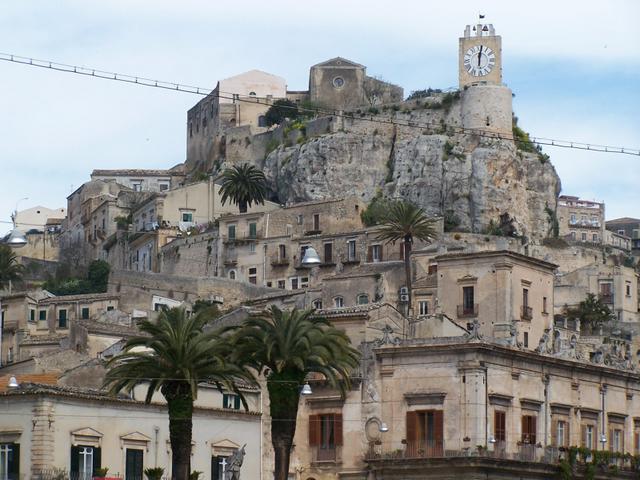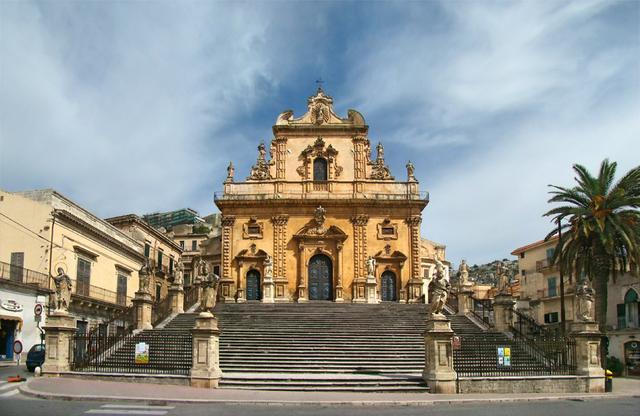Modica is a town in the province of Ragusa in Sicily, with a population of about 55,000.
Modica is one of the eight "Late Baroque Towns of the Val di Noto" UNESCO world heritage sites. It's in two parts: Modica Alta, higher and older, is perched on top of the southern Ibeli hill. Modica Bassa is built lower down the slopes and in the valley below. Like the other nearby towns, Modica was smashed in the earthquake of 1693, and rebuilt in baroque style. The broad main avenue of the lower town used to be the river, but after a disastrous flood in 1902 it was diverted, and the graceful boulevard was developed.
- Ufficio Turistico, Corso Umberto I, 141 (Palazzo della Cultura, +39 346 65 58 227. M-F 08:00–13:30 15:30–19:00, Sa 09:00–13:00 15:30–19:00.
Ufficio Turistico, Corso Umberto I, 141 (Palazzo della Cultura, +39 346 65 58 227. M-F 08:00–13:30 15:30–19:00, Sa 09:00–13:00 15:30–19:00.
A walk down from Modica Alta to Modica Bassa gives great views of the lower town. Either take the steps, or the zigzagging road.
- Duomo di San Giorgio. closed 12:30-16:00. The large Baroque cathedral, rebuilt after the 1693 earthquake, is dedicated to St George. Its roots are in the Middle Ages but the bar near the altar tracing the midday sun's annual track shows a modern enquiring spirit. You can climb the tower for great views of the city (€2).

- Castello dei Conti. A former residence of the Counts of Modica. Re-opened in late 2017 after years of restoration, but now appears to be closed again, fenced off behind construction barriers.
- Palazzo Napolino-Tommasi Rosso, Corso Francesco Crispi, 38-62. An elegant late Baroque palazzo.
- Palazzo Polara. 17th century.
- Chiesa di Santa Maria del Gesù.
- Chiesa di San Giovanni Evangelista.
Duomo di San Giorgio. closed 12:30-16:00. The large Baroque cathedral, rebuilt after the 1693 earthquake, is dedicated to St George. Its roots are in the Middle Ages but the bar near the altar tracing the midday sun's annual track shows a modern enquiring spirit. You can climb the tower for great views of the city (€2).
Castello dei Conti. A former residence of the Counts of Modica. Re-opened in late 2017 after years of restoration, but now appears to be closed again, fenced off behind construction barriers.
Palazzo Napolino-Tommasi Rosso, Corso Francesco Crispi, 38-62. An elegant late Baroque palazzo.
Palazzo Polara. 17th century.
Chiesa di Santa Maria del Gesù.
Chiesa di San Giovanni Evangelista.

- Modica Chocolate Museum and Civic Museum, Corso Umberto I, 149, +39 347 461 2771. Tu-Sa 10:00–14:00, 16:00–20:00; Su 10:00-13:00. The chocolate museum has an exhibition explaining Modica's unique way of preparing chocolate at low temperatures, which leaves sugar crystalized in the chocolate. The are sculptures and paintings on chocolate, and a huge map of Italy made of chocolate. €3.50 for each museum.
- Duomo di San Pietro. This notable church dedicated to St Peter crowned by a typical Sicilian Baroque belltower, 49 metres (161 ft) high.
- Chiesa rupestre di San Nicolò Inferiore, Piazzetta Grimaldi. Tu-Su 10:00-13:00 16:00-19:00. This "cave" church was dug into the rock. It was only discovered in 1987. The church is famous for rare frescoes on the bare rock in the late Byzantine style dating from the 12th to 16th centuries. Later excavations have unearthed some more crypts and tombs there. €2.
- Chiesa di Santa Maria di Betlem. In this church, rebuilt after the earthquake of 1693, there is a late Gothic chapel, Cappella Palatina or Cappella Cabrera (1474-1520), which is a listed Monumento nazionale. The arched entrance to the Chapel is richly decorated in Gothic Chiaramonte style with elements Arab, Norman and Catalan influence. It's regarded as one of the most beautiful monuments that architecture has produced in Sicily at the turn of the 15th and 16th centuries. In the church there is also the Presepe Monumentale, Monumental Nativity, (1881/82), with 62 terracotta figurines made in Caltagirone.
- Portale De Leva, Via De Leva, 8-24. Listed a National Monument, early 14th century, portal of the Palazzo De Leva is a fine example of the Gothic Chiaramonte style. The portal was probably an entrance to the church which was destroyed by an earthquake. Later it was incorporated into palazzo.
- Palazzo Grimaldi, Corso Umberto I, 106. An interesting example of Neo-Renaissance building. It belongs now to the Fondazione Grimaldi. A pinacoteca and a fotogallery are opened there.
- Palazzo degli Studi. 17th-19th century.
- Teatro Garibaldi. A small theatre built between 1815-1820 in Neoclassical style.
- Palazzo della Cultura, Corso Umberto I, 149. Winter: Tu-Su 09:00–13:00 15:30–19:30; summer: Tu-Su 10:00–13:00 17:00–20:00. Built in 16th-19th centuries, it hosts Museo Civico. €2.
- Chiesa del Carmine. and Ex. Convento del Carmine
- Palazzo San Domenico. The town hall, a former Dominican convent, and a former seat of the Spanish Inquisition in Sicily. In the lobby, there is a 17th-century entrance into an underground crypt, discovered in mid-20th century, containing some friars' bones. Some traces of frescoes can be seen there on the walls. Adjacent to the palazzo is the Chiesa di San Domenico.
- Palazzo Salemi. Built between 1631-1640. A former Palazzo Comunale.
- Palazzo Rubino. 17-18th century, Rococo style.
- Palazzo dei Mercedari. Now houses Biblioteca comunale and Museo delle Arti e delle Tradizioni Popolari.
Modica Chocolate Museum and Civic Museum, Corso Umberto I, 149, +39 347 461 2771. Tu-Sa 10:00–14:00, 16:00–20:00; Su 10:00-13:00. The chocolate museum has an exhibition explaining Modica's unique way of preparing chocolate at low temperatures, which leaves sugar crystalized in the chocolate. The are sculptures and paintings on chocolate, and a huge map of Italy made of chocolate. €3.50 for each museum.
Duomo di San Pietro. This notable church dedicated to St Peter crowned by a typical Sicilian Baroque belltower, 49 metres (161 ft) high.
Chiesa rupestre di San Nicolò Inferiore, Piazzetta Grimaldi. Tu-Su 10:00-13:00 16:00-19:00. This "cave" church was dug into the rock. It was only discovered in 1987. The church is famous for rare frescoes on the bare rock in the late Byzantine style dating from the 12th to 16th centuries. Later excavations have unearthed some more crypts and tombs there. €2.
Chiesa di Santa Maria di Betlem. In this church, rebuilt after the earthquake of 1693, there is a late Gothic chapel, Cappella Palatina or Cappella Cabrera (1474-1520), which is a listed Monumento nazionale. The arched entrance to the Chapel is richly decorated in Gothic Chiaramonte style with elements Arab, Norman and Catalan influence. It's regarded as one of the most beautiful monuments that architecture has produced in Sicily at the turn of the 15th and 16th centuries. In the church there is also the Presepe Monumentale, Monumental Nativity, (1881/82), with 62 terracotta figurines made in [[Caltagirone]].
Portale De Leva, Via De Leva, 8-24. Listed a National Monument, early 14th century, portal of the Palazzo De Leva is a fine example of the Gothic Chiaramonte style. The portal was probably an entrance to the church which was destroyed by an earthquake. Later it was incorporated into palazzo.
Palazzo Grimaldi, Corso Umberto I, 106. An interesting example of Neo-Renaissance building. It belongs now to the Fondazione Grimaldi. A pinacoteca and a fotogallery are opened there.
Palazzo degli Studi. 17th-19th century.
Teatro Garibaldi. A small theatre built between 1815-1820 in Neoclassical style.
Palazzo della Cultura, Corso Umberto I, 149. Winter: Tu-Su 09:00–13:00 15:30–19:30; summer: Tu-Su 10:00–13:00 17:00–20:00. Built in 16th-19th centuries, it hosts Museo Civico. €2.
Chiesa del Carmine. and Ex. Convento del Carmine
Palazzo San Domenico. The town hall, a former Dominican convent, and a former seat of the Spanish Inquisition in Sicily. In the lobby, there is a 17th-century entrance into an underground crypt, discovered in mid-20th century, containing some friars' bones. Some traces of frescoes can be seen there on the walls. Adjacent to the palazzo is the Chiesa di San Domenico.
Palazzo Salemi. Built between 1631-1640. A former Palazzo Comunale.
Palazzo Rubino. 17-18th century, Rococo style.
Palazzo dei Mercedari. Now houses Biblioteca comunale and Museo delle Arti e delle Tradizioni Popolari.
Modica is known for its artisanal chocolate production. Along Corso Umberto I and elsewhere, there are many shops selling this prized products, and offering samples of the many flavors it which it is produced.
- Antica Dolceria Bonajuto, Corso Umberto I, 159, +39 0932 941 225. 09:00-20:30. A pastry shop famous for their traditional chocolate. They also sell their products at some other shops in nearby towns including Ragusa.
- Taverna Nicastro, Via S Antonino 30, +39 0932 945 884. Tu-Sa 19:15-22:15; closed Su & M. Traditional Sicilian cuisine.
Antica Dolceria Bonajuto, Corso Umberto I, 159, +39 0932 941 225. 09:00-20:30. A pastry shop famous for their traditional chocolate. They also sell their products at some other shops in nearby towns including Ragusa.
Taverna Nicastro, Via S Antonino 30, +39 0932 945 884. Tu-Sa 19:15-22:15; closed Su & M. Traditional Sicilian cuisine.
- Nearby Ragusa and Syracuse are both must-see destinations.
- Cava D'Ispica. Approximately 13 km of extensive network of cave dwellings and other structures along river valley at the Hyblean plateau between the towns of Modica and Ispica.
Nearby [[Ragusa]] and Syracuse are both must-see destinations.
Cava D'Ispica. Approximately 13 km of extensive network of cave dwellings and other structures along river valley at the Hyblean plateau between the towns of Modica and Ispica.
